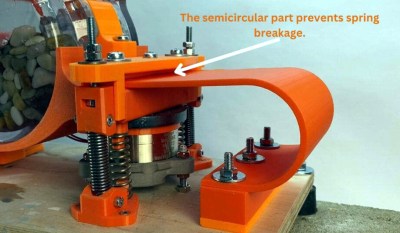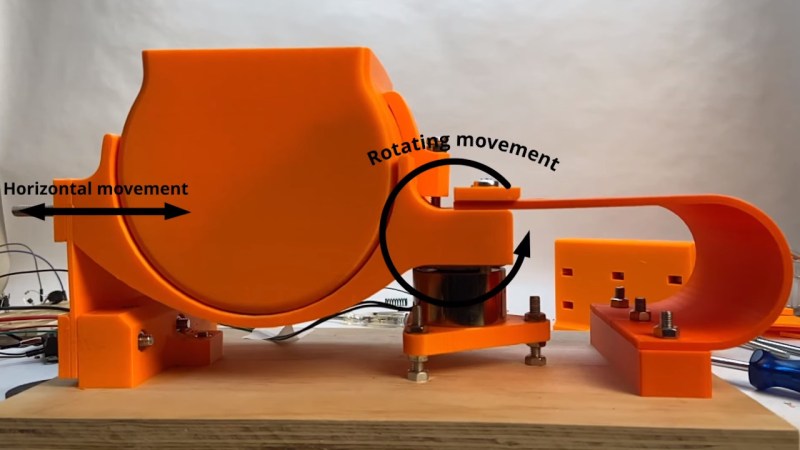If you’re reading Hackaday, there’s a good chance you had a rock tumbler in your younger days. Hell, we’d put odds on a few of you having one rumbling away in the background as you read this. They’re relatively simple contraptions, and a common enough DIY project. But even still, this largely 3D printed rock tumbler from [Fraens] is unique enough to stand out.
To make a basic rock tumbler, all you really need to do is rotate a cylindrical chamber and let physics do its thing. Such contraptions are known as, unsurprisingly, rotary rock tumblers. But what [Fraens] has put together here is a vibratory tumbler, which…well, it vibrates. If this was Rockaday we might go farther down this particular rabbit hole and explain the pros and cons of each machine, but the short version is that vibratory tumblers are more mechanically complex and are generally better suited to fine finish work than rotary tumblers which take a brute force approach that tends to round off the rocks.
 Anyway, while you could use a motor with an offset weight to generate the necessary vibrations, [Fraens] decided to go with a similar electromagnet arrangement to what he used in the vibratory bowl feeder he built last year. Pulsing the electromagnet pulls down the large 3D printed spring, which imparts not only the vertical motion you’d expect, but a touch of horizontal as well.
Anyway, while you could use a motor with an offset weight to generate the necessary vibrations, [Fraens] decided to go with a similar electromagnet arrangement to what he used in the vibratory bowl feeder he built last year. Pulsing the electromagnet pulls down the large 3D printed spring, which imparts not only the vertical motion you’d expect, but a touch of horizontal as well.
The end result is a “tossing” motion that gets the rocks inside the printed chamber moving around nicely. The motion can be fine tuned by adjusting the tension on the non-printed springs, which limit the range of the mechanism’s movement.
To drive the electromagnet, [Fraens] is using an Arduino and a L298N H-bridge motor controller. A pair of potentiometers serve as the controls, allowing the user to dial in the duty cycle of the magnet. Interestingly, despite being only rated for 12 V, the electromagnet is being fed off of 24 V for this project. This gives the tumbler a bit more oomph, but at the cost of heating up the magnet. To combat this, the Arduino code implements a 10 minute cool-down period for every hour of runtime. It sounds a little sketchy, but [Fraens] has had this thing cranking for four months now, and the Magic Smoke hasn’t escaped yet.
If you don’t have a 3D printer, or just don’t want to part with the amount of plastic it would take to extrude a machine of this scale, you could always take the easy way out and make a rotary tumbler out of an empty tomato sauce jar and a scrap motor.

















“If you’re reading Hackaday, there’s a good chance you had a rock tumbler in your younger days”
Well, I am, and I love HAD, but I’m certainly of different culture and not only I didn’t have that but this is also the first time I hear (read) about such a thing. What is this for? (asking seriously)
You don’t need to go outside, find a river, wet your hands and grab rocks.
See. Easy.
You can use them for metal finishing as an example. Put a knife blank in there with rocks, let it tumble for a while and you have a nice finish. If you add other materials, such as pieces of brass, and use blueing liquid (turns it black, not blue) you can get a finish that looks like it has gold flakes. Looks pretty cool.
In a nutshell: Rock tumblers are for polishing rocks to make them look prettier/smoother.
I had “rock tumbler”, but it was actually a mill for making black powder. After milling charcoal for 24h, you get powder so fine, that it almost acts like water.
Cleaning up metal parts as well. De-burring, rust removal, polishing etc. Fill the tub with grit, add the parts and let it run for a while.
You could use a big voice coil and magnet structure and play some rock music with lots of bass. Finish off with some smooth jazz.
Wonder how much microplastics they created and them dumped in to the environment…
umm, none? Tumbling rocks together doesn’t make “microplastics”
Yes, but tumbling them in a plastic container? The container must also be polished at the same time…
3d printing as well. Tons of it.
But the microplastics thing has left the stable. It’s over, all that is left is to wait for nature to adapt to it and make use of our mountains of toxic crap. Evolution will figure something out
Similar to the amount you created by purchasing the keyboard you typed that on.
This person is generating a truly massive amount of microplastic particles between the plastic tumbling container and the plastic beads used in some of the polishing steps.
I assume you drive a car with steel wheels, right? Every person with rubber wheels produces 1.2 kg of microplastics per year. I don’t think the tumbler should matter. Expansive monetary policy is causing unimaginable environmental destruction. We should be looking for solutions here. This problem needs to be discussed from the inside out and not to blame such small handicrafts.
And we need to stop blaming the consumer.
Yeah, the personal “pollution footprint” philosophy of environmentalism was quite literally created by a PR firm hired by British Petroleum for the task of taking focus of of themselves during the Deepwater Horizon spill.
People never remember that, they just take the bait and go at each other’s throats for the tiniest of infractions, as if that will ever make a dent.
THIS!
My first thought
I don’t know if its my brain going off the rocker but I’ve begun to be a lot more careful with chemicals. Hate microplastics, hate having to use chemical ridden shampoo and moisturisers, abhor having anything I’m eating to be in contact with plastic. I refuse to use aluminium based deodorants as well.
Nothing wrong with aluminium based deodorants. Science has proven it so. Please read a book.
No you don’t get it, its not a logical fear based on evidence. Its an anticipatory fear, what if I use a product containing X and it turns out X causes some random disease but it is only discovered 20 years in the future?
In 20 years we’ll all be dead anyway. Have a little fun.
I wouldn’t say it’s not based on evidence. In fact, it’s based on tons of evidence and tons of studies. The link between Aluminium (Al) and Alzheimer Disease (AD) is, as far as most scientists are concerned, proven. It’s also the reason why you won’t see any aluminium cookware in my house. There is a reason why AD became a widespread issue shortly after the introduction of aluminium cookware. AD was a pretty rare thing before the beginning of the previous century.
“The hypothesis that Al significantly contributes to AD is built upon very solid experimental evidence and should not be dismissed. Immediate steps should be taken to lessen human exposure to Al, which may be the single most aggravating and avoidable factor related to AD.”
https://pubmed.ncbi.nlm.nih.gov/21157018/
“Of all brains studied the highest aluminum concentrations were consistently found in AD tissues”
https://www.ncbi.nlm.nih.gov/pmc/articles/PMC6550484/
https://pubmed.ncbi.nlm.nih.gov/20378957/
“…this relationship falls short of all the criteria generally attributed to causation. ”
One reason I and others questions the causation-link is because when workers who have their hands and arms covered with orders of magnitude more aluminum powder (similar in size/shape/oxidation/etc of deodorant) on a daily basis are monitored long-term, they do not show a significant increase in AD outcome.
You have to go back to reddit and no, monolithic “science” has not “proven it so.” Anybody who speaks that way about science is far too stupid to use or understand it
If you live anywhere, your producing by products that harm the environment you can’t breathe without doing so. My advice to people who are afraid of causing environmental harm is to lock themselves in an air proof box and wait for the end result.
We are all humans and we are the best at destroying our planet, and we have tried since we developed the first fire. And became the ruination of the planet and the species of every kind. God gave us dominion over the planet and the animals, and not the destruction of it all.
It’s one guy tumbling some rocks, chill!